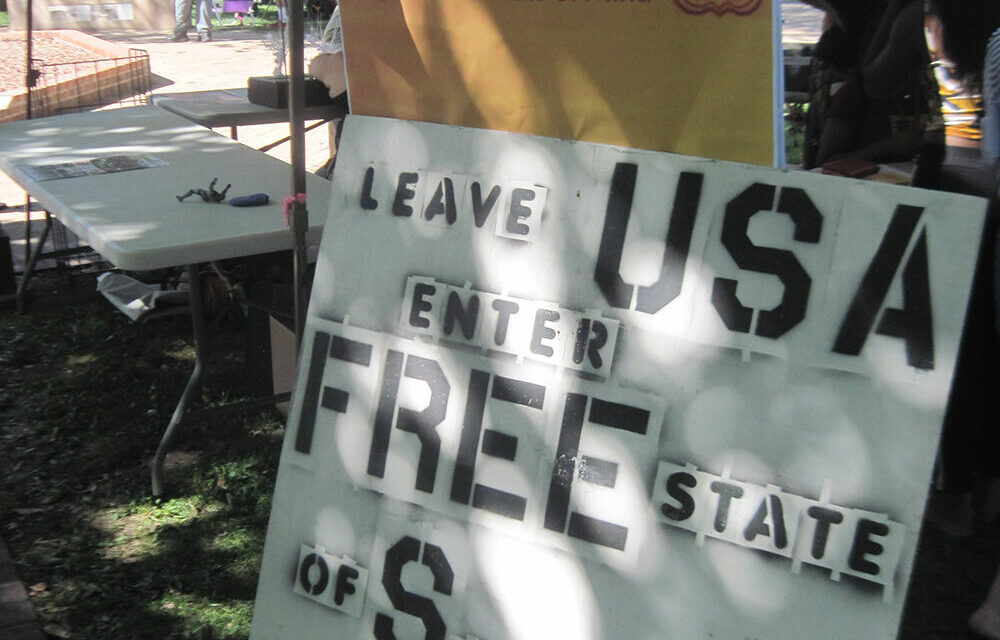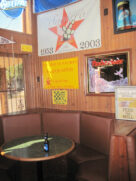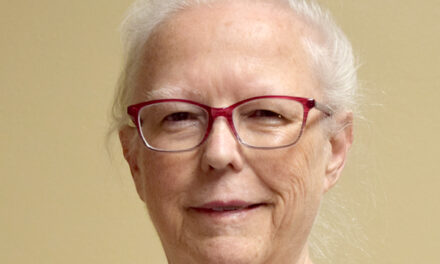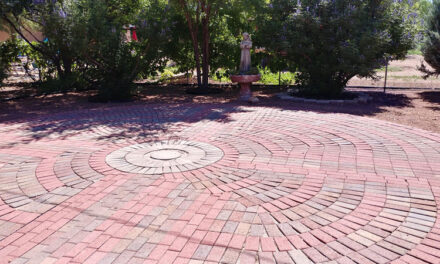(Part 1 of this two-part article told the story of how a simple traffic stop led Socorro city leaders to talk of seceding from New Mexico and the rest of the United States in 1953. Leaders of the so-called Free State of Socorro claimed that with no state or federal taxes, Socorro’s economy would boom while its population would more than triple. Even Life magazine ran a story about the rebel state and its prospects in June 1953.)
Home Rule
As with every secessionist movement, it soon became time to create a government to rule the Free State of Socorro. Leaders called for a constitutional convention to be held in October 1953.
Until then, leaders gathered — usually at local bars — to debate what sort of government would best suit their needs. Three factions discussed their options.
One faction, known as the Royalists, favored a constitutional monarchy with a Duke as Socorro’s supreme ruler. Royalists recognized E.M. Baca as the natural Duke of Socorro since he was a descendant of the Spanish recipients of the so-called Cabeza de Vaca land grant.
E.M.’s son, Philip, who operated the Deluxe Barbershop, would be the next in line of succession. Sarcastic observers noted this would make the barber E.M.’s “hair apparent.”
A second faction favored the creation of a democracy with elected representatives and leaders. Potential candidates began to jockey for position long before such a democracy could be formed. Rumored candidates included chamber of commerce manager Moon Mullins, attorney Waggoner and Mayor Holm Bursum.
Members of a third faction called themselves the Insurgents. Led by New Mexico Tech President E.J. Workman, the Insurgents wanted a Fascist dictatorship modeled after Francisco Franco’s government in Spain. We can only hope they were kidding.
Until the constitutional convention sorted all this out, Mayor Bursum was allowed to remain in office, although his title was vastly expanded. Those who attended a meeting at the Capitol Bar bestowed the elaborate title of “His Excellency, Presidente General and Lieutenant Wizard of the Wampum.”
A patriotic flag and currency
Socorro’s leaders tried to think of everything in the Free State’s early days. On March 26, the Chieftain announced that suggested names for the new state and suggested designs for its flag should be submitted to either the newspaper’s office or at the port of entry (the chamber of commerce’s building).
On May 7, the Chieftain reported that there were two finalist designs for the Free State’s flag. Both designs were the work of Joe Bagley. Neither was ever declared the winner, although one, a four-star banner (representing Socorro’s four precincts) appeared in the Chieftain’s masthead for several months.
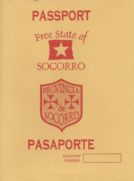
Although unsolicited, C.P. Klemz, of Albuquerque, submitted a design for Free State currency or “green backs.” One side of the bill had the words, “Free and Independent State of Socorro.” The other side showed a large animal amid some smaller beasts. The inscription read: “Great Seal” and the “Small Seals.” Most folks recognized Klemz’s contribution as a good-natured prank.
Free State defense
Despite their drive for independence from the United States, citizens of the Free State of Socorro were proud of their contributions to American history. In late April 1953, they announced plans to unveil a monument to commemorate the testing of the first atomic bomb.
Trinity Site is 50 miles southeast of Socorro, but the town claimed to have had several leading scientists stay at one of its hotels before the A-bomb test of July 16, 1945.
The monument was unveiled and dedicated on Sunday, April 26, 1953, with a parade that included National Guard troops, Boy Scouts and members of the Socorro High School band. Two thousand men, women and children lined the streets.
As a reliable ally to the U.S., Socorro hoped to depend on Uncle Sam for its meager defensive needs. Otherwise, the Socorro chief of police and the county sheriff would share the job of head of national defense.
The Free State even had its own Air Force, consisting of two small planes, although one of the planes crashed on a reconnaissance mission while searching for mosquito breeding places in the valley.
The rest of the story
So what ever happened to the Free State of Socorro and the people who played important roles in its creation?
Elmer Brasher, the man whose DWI arrest led to the discovery that Socorro had no ordinances, died in Albuquerque two years later, in 1955, at the age of 62. His obituary in the Albuquerque Tribune made no mention of the significant role he had played in the history of the Free State of Socorro.
Ed Stanton of the Socorro Chieftain can probably be called the main instigator of the independent state idea, if only to increase his newspaper’s sales for several months.
In 1957, Stanton invented another scheme to increase publicity and sales. By then he had become the publisher of not only the Chieftain, but also four other small-town newspapers across New Mexico. Rather than rely on conventional means to transport news from one newspaper office to the next, he and his family trained 30 homing pigeons to do the job.
The September 1953 issue of New Mexico Magazine included an article by the respected historian, Fray Angelico Chavez. Chavez argued that Socorro had been an “integral part” of New Mexico since Spanish rule. He contended that the Free State had absolutely no historical justification.
And what of the Free State of Socorro? Merchants continued to run ads with Free State specials through 1954, but there was little press coverage of the grand project as a whole by 1955.
The Free State’s constitutional convention was either never held or held around a table at a local bar with no one taking notes or making any decisive action before closing time.
In short, the Free State that had exploded like a firecracker in early 1953 fizzled just as quickly within months.
The Socorro chamber of commerce has made some use of the Free State’s quirky history, if only for some good humor and occasional publicity. For example, the chamber gave Free State tourist visas to members of the New Mexico Motor Hotel Association when they met in Socorro in 1964.
In 1971, the chamber sold Free State of Socorro license plates to raise money for city Christmas decorations. Free State of Socorro Chile Cook-offs were held at New Mexico Tech in the late 1970s and early 1980s, with winning contestants going to Texas to participate in the World Chile Cook-off Championship.
A bit more seriously, the Free State issue resurfaced in 1967 when Jerry Noll (a man of many aliases) published a manifesto claiming that he had legal connections to the Cabeza de Vaca land grant. Noll became part of Reies Lopez Tijerina’s statewide land grant movement, but he then faded from view as that larger movement waned in the 1970s.
More recently, a license plate was created to celebrate the Free State of Socorro’s 50th anniversary in 2003. Free State loyalists still staff a booth at Socorro’s annual fiesta where tourists can obtain license plates and passports for fun and posterity. Keeping a “free state of mind,” modern loyalists even maintain a popular site on Facebook.
The corner booth at the Capitol Bar, where local leaders once met to speak of grand schemes of independence, is still there with two Free State of Socorro banners on the wall above it. It’s the same booth that appeared in Life magazine’s article in 1953, but now few patrons remember its significance.
In the end, nothing much came of the Free State of Socorro, although in retrospect it appears to have been a comic-opera publicity stunt that put a little-known Southwest town on the national map, if only for a moment.
Epilogue
Two months ago, Chaves County State Sen. Cliff Pirtle introduced legislation that would allow counties to secede from New Mexico to either join a neighboring state or create a whole new one.
With arguments by legal experts and a lack of broad political support, Pirtle’s measure failed, just as the notion of a Free State had failed some 68 years before.
(Readers interested in joining the Valencia County Historical Society can contact its president, Richard Melzer, at [email protected].)
(La Historia del Rio Abajo is a regular column about Valencia County history written by members of the Valencia County Historical Society since 1998.

Richard Melzer
This article is a version of a chapter that appeared in the author’s new book, “Years Gone By in the Rio Abajo,” co-edited with John Taylor. Published by the Valencia County Historical Society, the book is available at the Los Lunas Museum of Heritage and Arts and on Amazon.com.
Opinions expressed in this and all columns of La Historia del Rio Abajo are the author’s alone and not necessarily those of the Valencia County Historical Society or any other group or individual.)

Richard Melzer, guest columnist
Richard Melzer, Ph.D., is a retired history professor who taught at The University of New Mexico–Valencia campus for more than 35 years. He has served on the board of directors of the Valencia County Historical Society for 30 years; he has served as the society’s president several times.
He has written many books and articles about New Mexico history, including many works on Valencia County, his favorite topic. His newest book, a biography of Casey Luna, was published in the spring of 2021.
Those interested in joining the Valencia County Historical Society should contact Dr. Melzer at [email protected].
